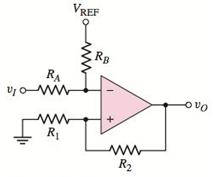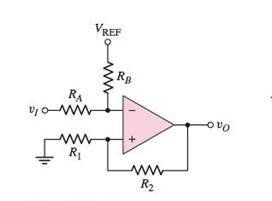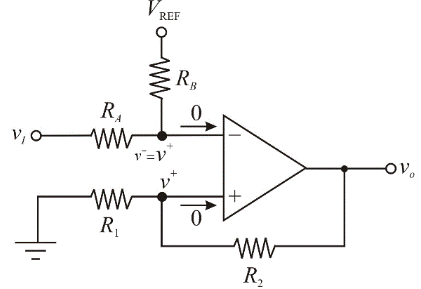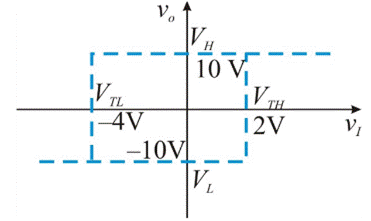
Concept explainers
Consider the Schmitt trigger in Figure P15.46. Assume the saturated outputvoltages are

Figure P15.46
(a)
To derive: The expression for the crossover voltage
Answer to Problem 15.46P
The expression for the crossover voltage
Explanation of Solution
Given:
The upper saturated output voltage,
The lowest saturated output voltage,

Calculation:
In an ideal op-amp, the inverting and non-inverting terminal currents are zero. Due to the virtual ground concept, the inverting and non-inverting node voltages are equal.
Given circuit can be represented as

Apply Kirchhoff’s current law at inverting node.
Hence, we get
Apply Kirchhoff’s current law at non-inverting node.
Substitute
When
The upper crossover voltage of Schmitt trigger
Similarly, when
The lower crossover voltage of Schmitt trigger
Conclusion:
Therefore, the expression for the crossover voltage
(b)
To find: the values of
To sketch: The voltage transfer characteristics.
Answer to Problem 15.46P
The required values are
The voltage transfer characteristics are shown in Figure 1
Explanation of Solution
Given:
The circuit voltages are:
Calculation:
The upper crossover voltage is
Therefore, the upper crossover voltage is
The lower crossover voltage is given by,
Therefore, the lower crossover voltage is
The given Schmitt trigger is positive feedback comparator.
Here, the transfer characteristic is a rectangle. Hence, it is called hysteresis which is a dead band. It is so called as the output is not changing
The output remains in the state indefinitely until input voltage crosses the any of the threshold levels.
The voltage transfer characteristics of the given Schmitt trigger is,

Figure 1
Conclusion:
Therefore, the required values are
Therefore, the voltage transfer characteristics are shown in Figure 1.
Want to see more full solutions like this?
Chapter 15 Solutions
MICROELECT. CIRCUIT ANALYSIS&DESIGN (LL)
- Q5: Given the following system: น -3 y= [4 -2] +3u Generate a model with states that are the sum and difference of the original states.arrow_forwardFind the state transition matrix. for the system whose simulation diagram is shown below: Uz x2 K 3 K=16arrow_forwardQ3: Find the state-space representation for the system given by:- + 16 + ၃- တိုင်း၍ရား +arrow_forward
- No chatgpt pls will upvote Already got wrong chatgpt answerarrow_forward"I need an expert solution with detailed steps for integration." The normalized Far-field pattern of an antenna is given by: E = √√sine (cosq) Determine: 1) Beam solid angle 2) Exact Directivity 0≤0≤ 180, while 0≤≤180, and 270 ≤≤ 360 3) HPBW in both azimuth and elevationarrow_forward"I need an expert solution with detailed steps for integration." Find Directivity, the effect aperture and aperture efficiency of the antenna, if it has physical aperture of 2.4 x 10-2-2 and the radiation intensity can be approximated by: U(0, 4) = (sesce 0°s0<20° 20°ses600 1.0°≤≤ 360°arrow_forward
- Don't use ai to answer I will report you answerarrow_forwardDon't use ai to answer I will report you answerarrow_forward"Can you explain the integration method to show the result?" The radiation intensity of an aperture antenna, mounted on an infinite ground plane with perpendicular to the aperture, is rotationally symmetric (not a function of 4), and it is given by U = π sin Find the approximate directivity (dimensionless and in dB) using (a) numerical integration. Use the DIRECTIVITY computer program at the end of this chapter. U sin ( sin ) sin (a) Directly Do = 14.0707 = 10log (14.0707) = 11.48 dBarrow_forward
- Don't use ai to answer I will report you answerarrow_forwardcomplete the table in the attached photos. instructions are below the tablearrow_forwardPlease show the solution and answers in each. Thank you. A 120 MVA, 19.5 kV generator has Xₛ = 1.5 pu and is connected to a transmission line by a transformer rated 150 MVA , 230 wye/18 delta kV Watts, and X = 0.1 pu. If the base to be used in the calculation is 100 MVA, 230 kV for the transmission line. a. Find the per-unit values to be used for the transformer and generator reactances. b. If the transformer delivers 80% of its rated capacity to the line at 220 kV, express the current in per unit. c. Find also the current in the genrator in amperes.arrow_forward
 Introductory Circuit Analysis (13th Edition)Electrical EngineeringISBN:9780133923605Author:Robert L. BoylestadPublisher:PEARSON
Introductory Circuit Analysis (13th Edition)Electrical EngineeringISBN:9780133923605Author:Robert L. BoylestadPublisher:PEARSON Delmar's Standard Textbook Of ElectricityElectrical EngineeringISBN:9781337900348Author:Stephen L. HermanPublisher:Cengage Learning
Delmar's Standard Textbook Of ElectricityElectrical EngineeringISBN:9781337900348Author:Stephen L. HermanPublisher:Cengage Learning Programmable Logic ControllersElectrical EngineeringISBN:9780073373843Author:Frank D. PetruzellaPublisher:McGraw-Hill Education
Programmable Logic ControllersElectrical EngineeringISBN:9780073373843Author:Frank D. PetruzellaPublisher:McGraw-Hill Education Fundamentals of Electric CircuitsElectrical EngineeringISBN:9780078028229Author:Charles K Alexander, Matthew SadikuPublisher:McGraw-Hill Education
Fundamentals of Electric CircuitsElectrical EngineeringISBN:9780078028229Author:Charles K Alexander, Matthew SadikuPublisher:McGraw-Hill Education Electric Circuits. (11th Edition)Electrical EngineeringISBN:9780134746968Author:James W. Nilsson, Susan RiedelPublisher:PEARSON
Electric Circuits. (11th Edition)Electrical EngineeringISBN:9780134746968Author:James W. Nilsson, Susan RiedelPublisher:PEARSON Engineering ElectromagneticsElectrical EngineeringISBN:9780078028151Author:Hayt, William H. (william Hart), Jr, BUCK, John A.Publisher:Mcgraw-hill Education,
Engineering ElectromagneticsElectrical EngineeringISBN:9780078028151Author:Hayt, William H. (william Hart), Jr, BUCK, John A.Publisher:Mcgraw-hill Education,





